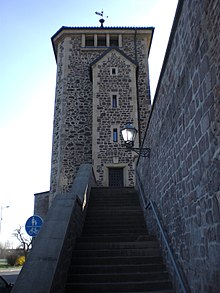Kiek in de Köken
Kiek in de Köken is a tower in Magdeburg that was part of the medieval city fortifications.
history
The tower was built in 1431 at about the same time as four or five other defensive towers , with which the citizens of Magdeburg reinforced the southeast corner of the city fortifications along the Elbe against the will of the archbishop . In addition to Kiek in de Köken, the tower located a little further south behind the Möllenvogtei exit has also been preserved. The background to the construction work was fears that the city could be attacked by insurgent Hussites . The dispute over the towers in the immediate vicinity of his palace, which the Archbishop did not want, dragged on from 1432 to 1435 and was at times fought with armed force, which led to Archbishop Günther's flight . In 1435, both sides reached a settlement according to which the towers were allowed to remain, but the archbishop shared ownership of the towers.
The floor plan of the tower is square with external dimensions of 7 × 7 meters. The average wall thickness is 1.28 to 1.45 meters. Like the other towers, Kiek in de Köken was built as a very slim tower. The outside facing the Elbe was designed with beveled outer edges. All towers, including Kiek in de Köken, had high Gothic spiers as roofs . Overhanging corner towers are shown on historical representations. Their presence can no longer be proven in today's building fabric, but it appears likely. Old views also show that the water level of the Elbe was right at the foot of the tower. Only when it was dry was there a strip of shore a few meters wide. The actual base of the tower, what was then the Fürstenufer, can no longer be recognized by today's Schleinufer , which was raised by around five meters in the 19th century .
Initially, palisade fences were built between the towers . 1525, according to other sources, a massive wall was built after 1530, to which a parallel wall about 12 meters to the west was added in the same century. The resulting kennel was filled in in 1722. The Fürstenwall was built , from the level of which the towers are only half as high as the level of the Schleinufer, which is also raised.
Kiek in de Köken has been redesigned several times. In the 18th century - the Gothic tower dome no longer existed - the tower was used at times as a detention center for disobedient soldiers. In a cityscape painted by Heinrich Mittag in 1823, the tower is shown with a pavilion-like tower. In the 19th century the tower was called the Bevern Tower . The tower belonged to the area of the Magdeburg Fortress . In 1899, the city finally tried successfully to acquire the tower from the military treasury. The tower now had an almost flat roof and served as a tool room for the municipal horticultural administration.
In the time of National Socialism , the tower was built for Nazi funerals and flags hall. Directly south of the tower, a National Socialist burial ground for the so-called Old Guard was built in December 1937 , at the southern end of which a celebration hall with carillon was built. Its ruins were torn down again in the 1970s. At the entrance to the square directly south of the tower, there was an imperial eagle on a shaft that is still preserved today . On the Fürstenufer there were bowls of flames and National Socialist symbols. There was an urn burial for a propaganda distributor of the NSDAP and an unknown burial. Both burials were reburied after the Second World War .
The tower was given an ashlar structure and a more monumental, warlike appearance, as well as a steep tent roof . Its current flat tent roof was built after 1945.
Todays use
The tower, which is owned by the city of Magdeburg, is now used sporadically for exhibitions.
The opening times are Monday to Sunday (excluding public holidays) from 10:00 am to 4:30 pm.
Surname
The name of the tower comes from Low German and means in High German look into the kitchen . From the tower one should have had a glimpse into the neighboring kitchen of the archbishop . Towers of the same name are located in Gdansk and Tallinn .
literature
- Folkhard Cremer: Dehio, Handbook of German Art Monuments , Saxony-Anhalt I, Magdeburg administrative district . Deutscher Kunstverlag , Munich / Berlin 2002, ISBN 3-422-03069-7 , p. 570.
- Heinz Gerling : Monuments of the city of Magdeburg . Helmuth-Block-Verlag, Magdeburg 1991, ISBN 3-910173-04-4 , p. 107.
- Helmut Menzel: The Fürstenwall . City Planning Office Magdeburg, 2001, p. 23 ff.
- Sabine Ullrich: Magdeburg - architecture and urban development . Verlag Janos Stekovics , Halle (Saale) 2001, ISBN 3-929330-33-4 , p. 57.
Individual evidence
- ↑ Gerling, Monument, p. 107.
- ↑ Menzel, Fürstenwall, p. 23.
- ↑ Menzel, Fürstenwall, p. 25.
- ↑ Ullrich, Magdeburg - Architecture and Urban Development, p. 57.
- ↑ Gerling, Monument, p. 107.
Coordinates: 52 ° 7 ′ 28.8 " N , 11 ° 38 ′ 13.3" E



